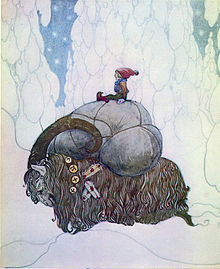
John Bauer (1912)
Julebukking is a costumed holiday tradition of Norwegian origin. [1]
The tradition of Julebukk (or Christmas buck in English) is believed to have originated in Norway where pagans worshiped the god, Thor, who traveled in his chariot drivien by two goats, Tanngrisnir and Tanngnjóstr. During holidays they would disguise their appearance and go house to house carrying a goat head. Christian missionaries modified the tradition and divorced its meaning from Paganism. The Yule Goat became one of the oldest Scandinavian and Northern European Yule and Christmas symbols and traditions. [2]
Though the practice may be dying out, it is still observed in areas in America with large populations of people of Scandinavian descent such as the rural areas of Wisconsin, Minnesota, North Dakota and in Petersburg, Alaska and Ketchikan, Alaska.
Between Christmas and New Years Day people wearing masks and costumes (Julebukkers) go door to door, where neighbors receiving them attempt to identify who is under the disguise. Julebukkers will often disguise their voices and body language to further the masquerade. Offering people holiday treats and something to drink is customary. Once identities are known and the food is eaten the Julebukkers continue to the next home.[3]
In one version of Julebukk, people go from door to door singing Christmas-songs. After they have sung, they are usually awarded with candy. Another tradition requires that at least one person from the visited household join the band of Julebukkers and continue to the next household.